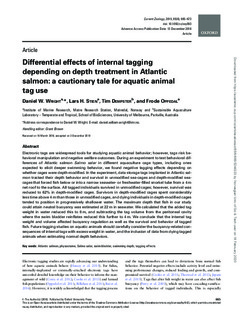| dc.description.abstract | Electronic tags are widespread tools for studying aquatic animal behavior; however, tags risk behavioral manipulation and negative welfare outcomes. During an experiment to test behavioral differences of Atlantic salmon Salmo salar in different aquaculture cage types, including ones expected to elicit deeper swimming behavior, we found negative tagging effects depending on whether cages were depth-modified. In the experiment, data storage tags implanted in Atlantic salmon tracked their depth behavior and survival in unmodified sea-cages and depth-modified sea-cages that forced fish below or into a narrow seawater- or freshwater-filled snorkel tube from a 4 m net roof to the surface. All tagged individuals survived in unmodified cages; however, survival was reduced to 62% in depth-modified cages. Survivors in depth-modified cages spent considerably less time above 4 m than those in unmodified cages, and dying individuals in depth-modified cages tended to position in progressively shallower water. The maximum depth that fish in our study could attain neutral buoyancy was estimated at 22 m in seawater. We calculated that the added tag weight in water reduced this to 8 m, and subtracting the tag volume from the peritoneal cavity where the swim bladder reinflates reduced this further to 4 m. We conclude that the internal tag weight and volume affected buoyancy regulation as well as the survival and behavior of tagged fish. Future tagging studies on aquatic animals should carefully consider the buoyancy-related consequences of internal tags with excess weight in water, and the inclusion of data from dying tagged animals when estimating normal depth behaviors. | |
